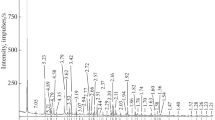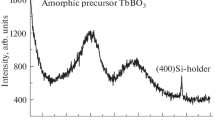Abstract
The article presents investigation of polymorphic transformations of the PtBi2 phases that occur during heating in inert atmosphere and in vacuum. A synthetic medium-temperature β-PtBi2 modification corresponding to the mineral insizwaite was studied by high-temperature X-ray diffraction and differential thermal analysis in the temperature range of 20–640°C. Two phase transitions are established by in situ X‑ray powder diffraction: from β into γ-PtBi2, and then into δ-PtBi2. Two endothermic peaks are recorded on the DTA curve, which correspond to the phase transitions. High-temperature X-ray powder diffraction data determined γ- and δ-PtBi2 formation at high temperature in inert atmosphere and in vacuum. Reverse polymorphic transformation were not observed by X-ray powder diffraction during cooling. It is suggested that insizwaite is a mineral geothermometer and its presence in the geological system implies certain temperature ranges of mineral formation environments.



Similar content being viewed by others
REFERENCES
Bhatt, Y.C. and Schubert, K., Crystal structure of Pt
4PbBi7 and PtBi2-h3, Zeit. fuer Metallk. 1980a, vol. 71, pp. 550–553.Bhatt, Y.C. and Schubert, K., Kristallstruktur von Pt Bi2*r, Zeit. fuer Metallk., 1980b, vol. 71, pp. 581–583.
Biswas, T. and Schubert, K., Structural investigation of alloys Pt–Ti–Pb and Pt–Pb–Bi, J. Less-Common Met., 1969, vol. 19, pp. 223–243.
Brese, N.E. and von Schnering, H.G., Bonding trends in pyrites and a reinvestigation of the structures of PdAs2, PdSb2, PtSb2 and PtBi2, Zeitsc. Anorg. Allgem. Chem., 1994, vol. 620, pp. 393–404.
Cabri, L.J. and Harris, D.C., The new mineral insizwaite (PtBi2) and new data on niggliite (PtSn), Mineral. Mag., 1972, vol. 38, pp. 794–800.
Furuseth, S., Selte, K., and Kjekshus, A., Redetermined crystal structures of PdAs2, PdSb2, PtP2, PtAs2, PtSb2, a-PtBi2, AuSb2, Acta Chem. Scand., 1965, vol. 19, pp. 735–741.
Kaiser, M., Baranov, A.I., and Ruck, M., Bi2Pt (hp9) by low-temperature reduction of Bi13Pt3I7: reinvestigation of the crystal structure and chemical bonding analysis, Z. Anorg. Allg. Chem., 2014, vol. 640, no. 14, pp. 2742–2746.
Okamoto, H., The Bi–Pt (bismuth–platinum) system, J. Phase Equil., 1991, vol. 12, no. 2, pp. 207–210.
Schubert, K., Bhan, S., Biswas, T.K., Frank, K., and Panday, P.K., Some structural data of metallic phases, Naturwissenschaften, 1968, vol. 55, no. 11, pp. 542–543.
Shipunov, G., Kovalchuk, I., Piening, B.R., Labracherie, V., Veyrat, A., Wolf, D., Lubk, A., Subakti, S., Giraud, R., Dufouleur, J., Shokri, S., Caglieris, F., Hess, C., Efremov, D.V., Buchner, B., and Aswartham, S., Polymorphic PtBi2: growth, structure and superconducting properties, Phys. Rev. Mater., 2020, vol. 4, no. 12, pp. 124202–124210.
Xu, C.Q., Xing, X.Z., Xu, X., Li, B., Chen, B., Che, L.Q., Lu, X., Dai, J., and Shi, Z.X., Synthesis, physical properties, and band structure of the layered bismuthide PtBi2, Phys. Rev., vol. 94, no. 16, p. 165119–165123.
Zhuravlev, N.N. and Stepanov, A.A., X-ray study of superconduction bismuth–platinum alloy with temperature range of 20–640°, Kristallografiya, 1962a, vol. 7, pp. 310–311.
Zhuravlev, N.N., Zhdanov, G.S., and Smirnova, E.M., Study of bismuth–platinum alloys in the region from 10 to 50 at % Pt, Fiz. Metal. Metalloved., 1962b, vol. 13, no. 4, pp. 536–545.
Funding
The study was carried out under the Russian Government Basic Research Program no. 121041500220-0 granted to the Institute of Geology of Ore Deposits RAS. Thermal analysis and electron-microprobe analysis were carried out at the Geoanalyst Common Use Center UB RAS under the Russian Government Basic Research Program no. AAAA-A19-119071090011-6 granted to the Zavaritsky Institute of Geology and Geochemistry UB RAS. High-temperature X-ray diffraction was performed at the Frumkin Institute of Chemistry and Electrochemistry RAS.
Author information
Authors and Affiliations
Corresponding authors
Ethics declarations
The authors declare that they have no conflicts of interest.
Rights and permissions
About this article
Cite this article
Mezhueva, A.A., Karimova, O.V., Uporova, N.S. et al. High-temperature Behavior of PtBi2 and Possibility of Using the Mineral Insizwaite as a Geothermometer. Geol. Ore Deposits 64, 292–299 (2022). https://doi.org/10.1134/S107570152205004X
Received:
Revised:
Accepted:
Published:
Issue Date:
DOI: https://doi.org/10.1134/S107570152205004X




